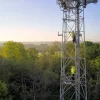Toshiba Extend Distance of UK Quantum Secured Fibre to 600km

A team of Toshiba’s scientists working at their Cambridge Research Laboratory in the UK have managed to extend the distance at which their quantum cryptography solution works in a fibre optic cable – Twin-Field Quantum Key Distribution (QKD) – from around a range of 100-200km to 600km.
Why does any of this matter, you ask? Quantum secure links are often said to be virtually “un-hackable” because they rely on the use of single particles of light (photons) to transmit special data encryption “keys” (QKD). Should this communication be intercepted, the sender will be able to tell that the link has been tampered with, and the stolen photons cannot then be used as part of the key, thus rendering the data stream incomprehensible to a hacker.
At the end of last year BT and Toshiba succeeded in establishing the UK’s first “industrial deployment” of a quantum-secure network using Openreach’s “standard” fibre optic infrastructure (here). The key rate of the QKD system ran at just 1.1Mbps (each encryption key has a length of 256 bits), while the encrypted data link itself was running at 10Gbps. But it could go up to several hundred gigabits and at distances of up to 120km.
Advertisement
Sadly, commercial QKD systems have generally remained limited to around 100-200km of fibre, which isn’t much good if what you want to do is something much bigger, such as to secure a transatlantic submarine cable from the possibility of a cable tapping Russian sub etc.
What has Toshiba done?
One of the most difficult technological challenges in building such links, is the problem of how to transmit quantum bits over long optical fibres. Small changes in the ambient conditions, such as temperature fluctuations, cause the fibres to expand and contract, thereby scrambling the fragile qubits, which are encoded as a phase delay of a weak optical pulse in the fibre.
Toshiba has managed to boost this by introducing a novel “dual band stabilisation” technique. This sends two optical reference signals, at different wavelengths, for minimising the phase fluctuations on long fibres. The first wavelength is used to cancel the rapidly varying fluctuations, while the second wavelength, at the same wavelength as the optical qubits, is used for fine adjustment of the phase.
After deploying these new techniques, Toshiba found it is possible to hold the optical phase of a quantum signal constant to within a fraction of a wavelength, with a precision of 10s of nanometers, even after propagation through 100s of km of fibre. Without cancelling these fluctuations in real time, the fibre would expand and contract with temperature changes, scrambling the quantum information.
Advertisement
The first application for this will of course be their long distance QKD solutions, which when combined with their existing Twin Field QKD protocol have now demonstrated QKD working over 600km of fibre, for the first time.
Mirko Pittaluga, First Author of the Research, said:
“This is a very exciting result. With the new techniques we have developed, further extensions of the communication distance for QKD are still possible and our solutions can also be applied to other quantum communications protocols and applications”.
The details of the advancement have today been published in the scientific journal, Nature Photonics. The work was partially funded by the EU through the Horizon 2020 project, OpenQKD. Corning Inc collaborated in the work by providing the SMF-28® ULL fibre used in the study. The team is now engineering the proposed solutions to simplify their future adoption and deployment.
Toshiba’s development represents a huge improvement, although it’s worth remembering that many subsea fibres can run for thousands of kilometres and thus there’s still room for improvement. Likewise, while this may secure the communication, it doesn’t stop hackers infiltrating the sending and receiving ends of those links. But that’s a different, albeit more familiar, challenge.
Mark is a professional technology writer, IT consultant and computer engineer from Dorset (England), he also founded ISPreview in 1999 and enjoys analysing the latest telecoms and broadband developments. Find me on X (Twitter), Mastodon, Facebook, BlueSky, Threads.net and Linkedin.
« AltNet Full Fibre ISPs Target 29.9 Million UK Premises by 2025
Neos Networks Unbundles a Further 201 UK Exchanges for Fibre »





















































Let’s hope Quantum Secured Fibre can be a big success. It would strengthen the UK economy against our Iranian, Russian and Chinese enemies currently waging cyber warfare against us.
I’d love to see how a Russian submarine could tap a transatlantic cable. Repairs of subsea cables require large ships to pull the cable up, and perform repairs, so tapping into a subsea cable underwater, would require a huge submarine with a dry area large enough to work on the cable/repeater, once pulled in. Once they have the repeater on board, they’d have to access the equipment/fibres and work on the system while, it’s powered and interrupt the data to split off some of the light. Once they access the fibre, they’d need supercomputers to analyse the Terabits per second data streams to find what they’re looking for. Good luck to anyone wanting to tap subsea communications, a phenomenally difficult and dangerous endevour.